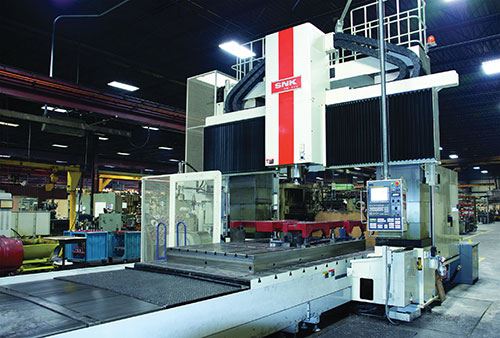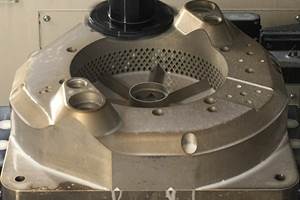Gaining Capabilities with a Five-Face Machining Center
By using the RB-4VM five-face bridge-type machining center from SNK America Inc., Marvel Manufacturing Co. Inc. was able to produce complex parts for band saws with increased precision.
As shops require ever tighter tolerances from their sawing operations, band saw manufacturer Marvel Manufacturing Co. was challenged to bring to market new models with increased capacity. These models required producing a large number of complex parts with tight tolerances, though, so Marvel invested in a five-face bridge mill from SNK America Inc. Not only did the machining center increase precision, but it also improved efficiency and production speed.
Founded in Chicago, Ill., in 1904 as the family-run Armstrong-Blum Co., the manufacturer eventually moved to its current headquarters in Oshkosh, Wis., where it designs and manufactures industrial-grade vertical and horizontal band saws for metal cutting operations. In 2004, a key group of employees bought the company and renamed it Marvel Manufacturing Co.
According to Marvel President John Petek, even though the company has been producing saws for a long time, it felt the pressure to constantly innovate and improve its products to become the “go-to” company in the market. By continually developing new products and accommodating customer requests, Marvel soon realized its parts production requirements had outgrown its existing machining capabilities, says Product Manager Allen Goranson. “You can’t build a quality saw without quality components.”
Marvel needed to find a machining solution that would enable high-speed production of precision parts while improving cost efficiency throughout the production process. In addition, the new machine would have to mill larger parts to ultra-precise tolerances, as saws are increasingly built to handle larger workpieces and more complex components.
To help meet these challenges, Marvel turned to machine tool distributor Premier Machine Tool, where co-owners AJ Schweda and Josh Witt recommended the RB-4 bridge-type, five-sided machining center from SNK America (Mount Prospect, Ill.).
“We were impressed with the thoroughness with which they approached the selection process,” says Mr. Schweda. “Not only were they particular about what the machining center parameters should cover, but they placed a strong emphasis on partnering with a manufacturer that stood behind its product and provided excellent application and support services after the sale was made. Once we heard that, we knew SNK would be a perfect match.”
The RB series is designed for machining a wide range of parts. Its worktable measures 78 by 236 inches and accommodates workpieces as heavy as 33,000 pounds. With these specifications, the RB-4 can machine all the parts in the Marvel line, including the most complicated tables for its Vertical Tilt Frame band saws. The extra-large Y- and Z-axis travels easily handle large and extra-long workpieces such as the G800 table, the company says.
Initially, Marvel used the RB-4 to prototype large components for its new lineup of larger capacity saws for the steel mill market. It handled the steel weldments with overflow capacity for large cast iron components. Soon, however, the Marvel team opted to revamp the entire process to better use the RB-4 as well as its existing machining centers.
Almost overnight, the RB-4 showed major improvements in precision, efficiency and production speed. The versatility of the automatic right-angle attachment changer, the cutting capability, and overall machine rigidity and reliability, made the RB-4 the perfect fit for Marvel’s machining requirements, says Mike Schlipf, regional sales manager for SNK.
To further enhance efficiency, the company added probing options for part measurement and tool setting, along with cutting load monitoring and a 120-tool ATC, which enables Marvel to run even the most complex components lights out.
This is especially helpful for Marvel’s Mark II column. According to Marvel Senior Industrial Engineer John Hefter, SNK applications engineers helped the company get to the point in which its operator could load the part, hit cycle start and return to a finished part in the morning.
It works like this: Each tool is touched off on the tool setting probe to verify that it is secured. This probe then verifies the tool’s length and the process repeats for the next tool. If the tool probing routine finds that something changed within the preset parameters, the machine will be stopped immediately to eliminate damage to the part or the next tool. This greatly increases efficiency while reducing downtime, Mr. Hefter says.
For increasing both precision and speed in deep-cavity machining, the RB4’s W axis is key. “The problem is that a lot of our parts are short—they don’t stand very tall,” Mr. Hefter says. “On our older gantry machine, the quill had to come out so far that you would lose some of your rigidity. You had to slow down your speeds and feeds to get finishes and sizes, but on the SNK you don’t.”
Jobs can be run at optimal speeds and feed rates because the operator can reduce tool and quill extensions to improve overall cutting rigidity. This eliminates deflection and tapered bores because everything is so much tighter and more accurate, Mr. Hefter says.
Since installation, the RB-4 has helped Marvel decrease downtime, increase product quality, and increase productivity by 30 percent compared with its previous machining center.
Related Content
Twin Spindle Design Doubles Production of Small Parts
After experiencing process stalls in the finishing stage of production, Bryan Machine Service designed an air-powered twin spindle and indexable rotating base to effectively double its production of small parts.
Read MoreWatchmaking: A Machinist’s View
Old-world craftsmanship combines with precision machining on a vertical machining center and Swiss-type lathe to produce some of the only U.S.-made mechanical wristwatch movements.
Read More10 Ways Additive Manufacturing and Machining Go Together and Affect One Another
Forget “additive versus subtractive.” Machining and metal additive manufacturing are interconnected, and enhance the possibilities for one another. Here is a look at just some of the ways additive and machining interrelate right now.
Read MoreIn Moldmaking, Mantle Process Addresses Lead Time and Talent Pool
A new process delivered through what looks like a standard machining center promises to streamline machining of injection mold cores and cavities and even answer the declining availability of toolmakers.
Read MoreRead Next
3 Mistakes That Cause CNC Programs to Fail
Despite enhancements to manufacturing technology, there are still issues today that can cause programs to fail. These failures can cause lost time, scrapped parts, damaged machines and even injured operators.
Read MoreObscure CNC Features That Can Help (or Hurt) You
You cannot begin to take advantage of an available feature if you do not know it exists. Conversely, you will not know how to avoid CNC features that may be detrimental to your process.
Read MoreThe Cut Scene: The Finer Details of Large-Format Machining
Small details and features can have an outsized impact on large parts, such as Barbco’s collapsible utility drill head.
Read More






























